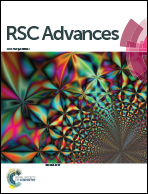Novel asymmetrical single- and double-chiral liquid crystal diads with wide blue phase ranges†
Abstract
In this study, two series of novel asymmetrical single- and double-chiral liquid crystal diads using a central linker to link two different mesogenic cores were successfully synthesized. The effects of the position of chiral centers and the number of aromatic rings on the mesomorphic and electro-optical properties were investigated. We found that diads III-N (where N = A, B, C and D) have better mesophasic properties than II-N (where N = A, B, C, D and E). Compared with III-C with a chiral center at the terminal alkoxyl chain, diad III-D exhibited the widest temperature range of BPI (ca. 31 °C) as the chiral center was introduced to the central linker. Besides III-D, BPs were also observed in diads II-B and III-B with a chiral center at the central spacer. According to our experimental results and molecular modeling, the mesomorphic properties and temperature ranges of BPs will be affected by the values of biaxiality and dipole moment, along with the bent shape of molecular geometry. Therefore, we demonstrated the first example of asymmetrical single- and double-chiral liquid crystal diads involved chiral centers located at the central linker to exhibit BPs, including the mesophases of BPI and BPIII, which might offer new BP single-components to the future applications of eutectic liquid crystal mixtures with wide BP ranges.


 Please wait while we load your content...
Please wait while we load your content...